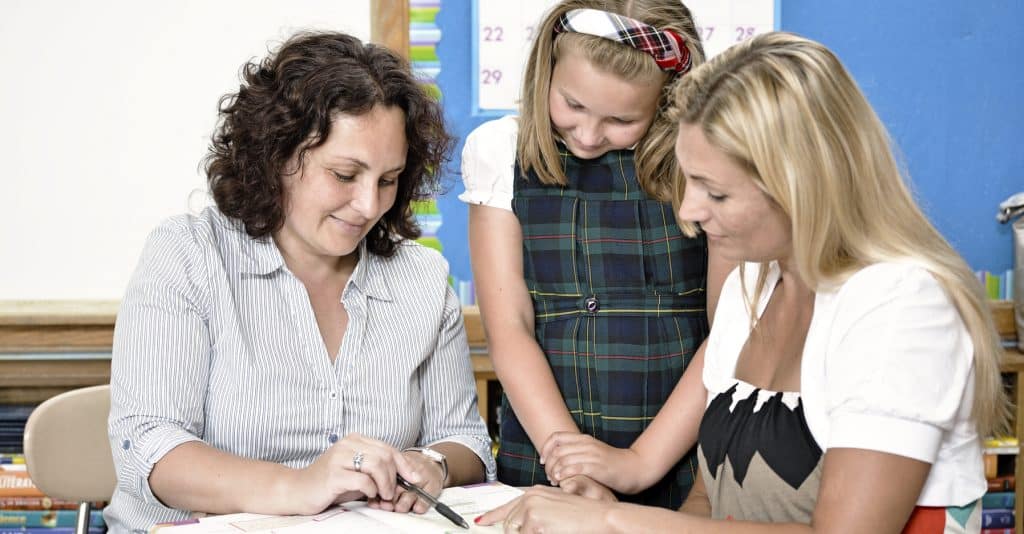You may know your ABCs but what about your XYZs, as in generations? It’s so easy to put together a classroom Facebook group or send a school email without a second thought. However, depending on the age of your student’s parents, some methods of digital communication may be more effective than others.
A parent’s digital preferences often differ based on their generation in ways you might not expect. It’s essential for teachers to be mindful of these differences while communicating to develop strong, positive relationships with families.
Today, we’ll go over a few tips for digitally communicating with parents based on their generation label (X, Y, or Z). Then, we’ll share five tips for communicating with any parent to boost parent engagement in your classroom.
Generation X Communication Characteristics

Before we go into the personalities and communication preferences of Generation X, let’s define their age range. Gen X parents are those born between 1965 and 1980 and are currently between the ages of 39 and 54.[8] Your Gen Xers are most likely the parents of older elementary or middle and high school students. If you have students whose grandparents are your main contact for school, it’s a good bet many of those grandparents belong to Generation X.
Gen X was the first generation to regularly use modern communication technology (think computers and cell phones) from home at a younger age.[4] Because they can remember a time before this technology, however, they may not be as dependent on it as later generations. They are generally comfortable with technology and navigate smartphones or social media platforms with little trouble. Gen Xers are more likely to prefer in-person parent-teacher communication than younger generations, but they still appreciate digital messages.
Email is the preferred form of digital communication for Gen X parents.[4] Although they’re comfortable with in-person communication, they appreciate the convenience of tech-based options.[11] A classroom newsletter or weekly update on student progress are both great ways to engage these parents. The most important thing, however, is to keep these messages succinct. As a whole, Gen X parents prefer brief messages to lengthier ones.[11]
How Millennial Parents Prefer to Communicate
The communication characteristics of Generation Y (or Millennial) parents are distinct from any generation before (or after) them. The Millennial birthdate range is 1980–1995, making them between 24 and 39 years old.[6] Millennials are no longer elementary or secondary students themselves, though they may still be students in college or graduate school. If you teach elementary school, many of your students’ parents will belong to Generation Y.
Previous generations often view Millennials as technologically sophisticated but deficient in face-to-face communication skills.[1] This is not necessarily true, but Millennial parents are more tech-savvy than Gen Xers. They expect technology to be integrated into educational communication and use it on a more regular basis.[3]
The best way to communicate with Millennials as a teacher is through text. In fact, 68% of all Millennials report they text “a lot” every day, in comparison to 47% of Gen Xers.[9] It might be helpful to create a group text with all of the parents who are interested to provide updates on school events and assignments. Additionally, a short personal text to Millennial parents on their child’s progress can go a long way.
Additionally, Millennials spend an average of six to seven hours per week on social media.[2] Consider putting together a Facebook group or Twitter page for your parents to join or follow. That way, you can provide a space for these parents to stay up-to-date on class announcements and communicate with each other.
Communicating with Generation Z Parents
 Generation Z is defined as those born between 1995–2015, making them between 4 and 24 years old.[7] This means that not only are Gen Zers your students, but they are some of your youngest parents as well.
Generation Z is defined as those born between 1995–2015, making them between 4 and 24 years old.[7] This means that not only are Gen Zers your students, but they are some of your youngest parents as well.
Many still lump older Gen Zers with Millennials, but there are distinct ways in which Generation Z prefers to communicate.[6]
For Gen Z, their primary means of technical communication has not been computers or email but mobile devices.[6] They were young when smartphones and tablets came out, and while Millennials adapted to these resources, Gen Zers are digital natives and communication using these platforms is a basic expectation.[5] Additionally, Gen Z communication expert Sarah Weise notes that this generation tends to have many social media accounts, “curating each specific one for various purposes.”
Digital communication is key for Gen Z, as 65% report that they communicate online more frequently than in person.[10] Because this generation feels at home on social media, creating a class group or page may be a wise choice. When surveyed, over 58% of Gen Zers reported preferring group collaboration and communication—which is easiest over social media.[12] If you currently use a parent-teacher communication app to communicate with families, Gen Z parents have been using apps from a young age and should feel comfortable using that as well.
Additionally, Gen Zers have a shorter attention span than Millennials—8.5 seconds compared to 12 seconds, according to Sarah Weise.[13] While brevity is always helpful for digital communication, it’s important to make every word count with Gen Z parents. Aim for short and sweet messages with the most important information first. If you have additional thoughts or questions that might not fit within a short message, consider scheduling a meeting instead.
5 General Tips for Parent-Teacher Communication
We’ve just discussed the distinct ways that teachers can communicate with parents based on their generation. It’s important to remember, however, that no family will fit a cookie cutter communication style based on their generation alone. Every parent is different, and the best way to keep them up-to-date on school events is to get to know their personal preferences and keep the lines of communication open.
Here are five helpful strategies for communicating with parents that teachers can use regardless of generation:
- Prioritize two-way communication, which is more effective for involving parents.[14] Two-way communication involves back-and-forth messaging, whereas one-way communication doesn’t allow parents to respond (think newsletters).
- Some parents may not be able to meet you in person due to busy work schedules or transportation issues. Provide alternative ways to meet with these families, like video chats or phone calls, to discuss student progress at checkpoints throughout the year.[15]
- Ask parents about their communication preferences at back-to-school night. That way, you can tailor the way you reach out to them in ways that are most likely to be helpful.
- If you notice something positive about a student, share it with their parents! This builds relationships and helps families feel comfortable coming to you with questions as they arise.
- Keep a parent-teacher communication log throughout the school year to make a note of what does and doesn’t work with families.
Sources:
- Hartman, J.L., and McCambridge, J. Optimizing Millennials’ Communication Styles. Business and Professional Communication Quarterly, March 2011, 74(1), pp. 22-44.
- Contreras, C. 7 Ways To Engage Millennials and Gen Z On Social Media In 2018. Retrieved from socialmediaweek.org: https://socialmediaweek.org/blog/2017/12/7-ways-engage-millennials-gen-z-social-media-2018/.
- Childs, R. D., Gingrich, G., & Piller, M. The future workforce: Gen Y has arrived. The Public Manager, 2009, 38(4), pp. 21-23.
- Notre Dame of Maryland University. The Evolution of Communication Across Generations. Retrieved from ndm.edu: https://online.ndm.edu/news/communication/evolution-of-communication/.
- Granados, N. Gen Z Media Consumption: It’s A Lifestyle, Not Just Entertainment. Retrieved from forbes.com: https://www.forbes.com/sites/nelsongranados/2017/06/20/gen-z-media-consumption-its-a-lifestyle-not-just-entertainment/#2881b1c718c9.
- Williams, A. Move Over, Millennials, Here Comes Generation Z. Retrieved from nytimes.com: https://www.nytimes.com/2015/09/20/fashion/move-over-millennials-here-comes-generation-z.html/.
- Browmwich, J.E. We Asked Generation Z to Pick a Name. It Wasn’t Generation Z. Retrieved from nytimes.com: https://www.nytimes.com/2018/01/31/style/generation-z-name.html.
- Boyle, M., and Townsend, M. Reality Bites Back: To Really Get Gen Z, Look at the Parents. Retrieved from bloomberg.com: https://www.bloomberg.com/news/articles/2019-07-29/how-gen-x-parents-raised-gen-z-kids-different-than-millennials.
- Alton, L. Phone Calls, Texts Or Email? Here’s How Millennials Prefer To Communicate. Retrieved from Forbes.com: https://www.forbes.com/sites/larryalton/2017/05/11/how-do-millennials-prefer-to-communicate/#1ac686606d6f.
- Bradbury, R. The Digital Lives of Millennials and Gen Z. Liveperson, 2017, pp. 1-24.
- Getting Smart Staff. Communicating Across Generations. Retrieved from gettingsmart.com: https://www.gettingsmart.com/2015/01/communicating-across-generations/.
- Belinne, J. Gen Z: The Communication Generation. Retrieved from naceweb.org: https://community.naceweb.org/blogs/jamie-belinne/2019/07/23/gen-z-the-communication-generation.
- Weise, S. Snackable Lesson 1 of 7: Generational Traits. Retrieved from sarahweise.com: www.sarahweise.com/genz-snackable-lesson1.
- Epstein, J.L., & Sheldon, S.B. Getting Students to School: Using Family and Community Involvement to Reduce Chronic Absenteeism. School Community Journal, 2004,14(2), pp 39-56.
- Machen, S.M., Wilson, J.D., and Notar, C.E. Parental involvement in the classroom. Journal of Instructional Psychology, March 2005, 32(1), pp. 13-16.

